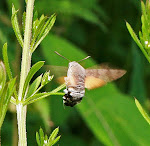
June 18-21, 2011:
Greece is renowned for its rich butterfly fauna with the mountains of the northern Peloponnese being especially favoured. A few days were spent here recently on the slopes of Chelmos at the height of the season and in perfect weather. Some of the species seen are shown here although some families such as the 'blues' and 'skippers' are difficult to identify and will be covered in a second part later.


[Clouded Yellows]
The mountain of Chelmos reaches an altitude of approximately 2400 metres a.s.l. but up to about 1800 metres it can be reached by the surfaced approach road originally constructed for skiing. The middle slopes are heavily afforested with Pinus cephalonica but at around 1700 metres this gives way to the scrub and short dry grassland known as the Xerocampos (dry fields). This latter area, the margins of the approach road, and the glades within the forest, all abound with butterflies. Some were very common here such as Clouded Yellows, Brimstones, and several species of blues. Up on the Xerocampos Glanville and Spotted Fritillaries were flying and the occasional Swallowtail and Camberwell Beauty were seen patrolling higher on the mountain.


[Glanville Fritillaries]


[Spotted Fritillaries, male above, female below]

[Swallowtail]

[Camberwell Beauty]
In one of the glades amongst the pines a beautiful rich-coloured and rare Grecian Copper nectared on a species of Squinancywort, Cleopatras did similarly on the local variant of Common Vetch, whilst a pristine Black-veined White rested close by. On a branch overhanging a stream at lower altitude, a Southern White Admiral sunned itself.

[Grecian Copper, see top photo also]

[Cleopatra, a more colourful relative of the Brimstone]


[Black-veined White]

[Southern White Admiral. Distinguished from the more common White Admiral in having only a single row of marginal spots on the underwide of the wings]

[Forest glade frequented by several species including the Grecian Copper]
.jpg)






No comments:
Post a Comment